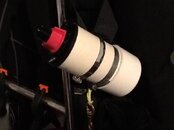CuzzA
Wetwork for Hire
Hello All,
I'm interested in hearing some feedback on my DIY PLB Dive Canister. I always carry my ACR ResQLink+ whenever I venture off the beaten path, on my boat and since recently becoming certified I want the device with me at all times anywhere in the world. So when I began to research dive canisters/housings for PLB's I was quite shocked at the price the manufacturers were asking. In fact, it actually struck a nerve they were asking damn near more than the PLB itself. Now, I'm not trying to be cheap, but I also know when I'm getting ripped off and I simply refuse to support someone who is gouging. That being said, I built my own.
It's an obviously simple design. 3" pvc pipe, 3" pvc cap and a 3" pressure test plug. I used two stainless steel bands and Velcro to secure it to my BCD tank webbing. I also tied a bolt snap to it. I used my FoodSaver vacuum to seal the PLB for added protection. The PLB unit itself is water resistant and can withstand a limited amount of time at depth. I submerged the unit in my 7' deep pool for 24 hours and it was bone dry. Of course 7' feet is nothing compared to recreational diving depths.
So again I'm looking for critisim and critiquing of this design. Am I good to go? Going to have trouble with it? Any alternatives? It is rather bouyant so I'm also considering adding some lead to it. Thanks for any advice.
I'm interested in hearing some feedback on my DIY PLB Dive Canister. I always carry my ACR ResQLink+ whenever I venture off the beaten path, on my boat and since recently becoming certified I want the device with me at all times anywhere in the world. So when I began to research dive canisters/housings for PLB's I was quite shocked at the price the manufacturers were asking. In fact, it actually struck a nerve they were asking damn near more than the PLB itself. Now, I'm not trying to be cheap, but I also know when I'm getting ripped off and I simply refuse to support someone who is gouging. That being said, I built my own.
It's an obviously simple design. 3" pvc pipe, 3" pvc cap and a 3" pressure test plug. I used two stainless steel bands and Velcro to secure it to my BCD tank webbing. I also tied a bolt snap to it. I used my FoodSaver vacuum to seal the PLB for added protection. The PLB unit itself is water resistant and can withstand a limited amount of time at depth. I submerged the unit in my 7' deep pool for 24 hours and it was bone dry. Of course 7' feet is nothing compared to recreational diving depths.
So again I'm looking for critisim and critiquing of this design. Am I good to go? Going to have trouble with it? Any alternatives? It is rather bouyant so I'm also considering adding some lead to it. Thanks for any advice.
Attachments
Last edited:





